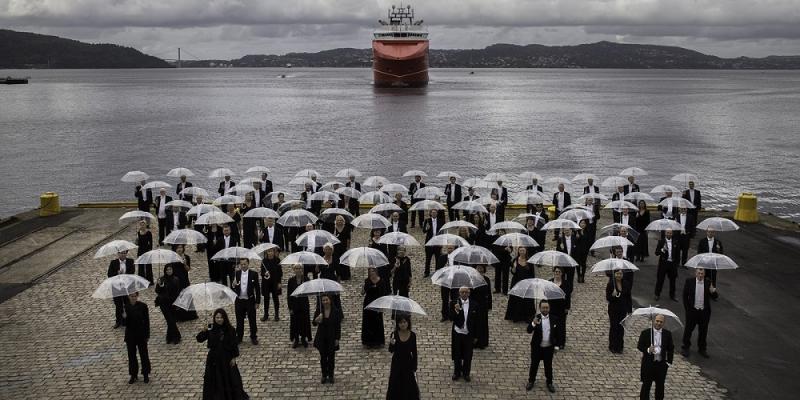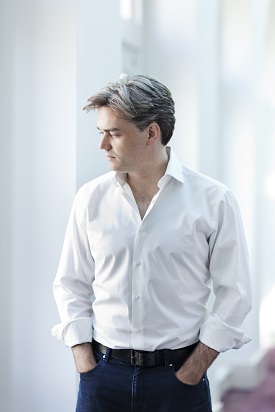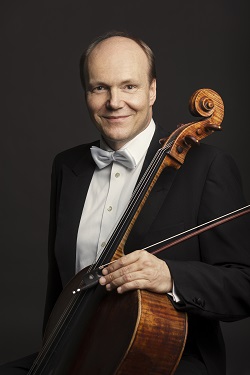Mørk, Bergen Philharmonic, Gardner, Cadogan Hall | reviews, news & interviews
Mørk, Bergen Philharmonic, Gardner, Cadogan Hall
Mørk, Bergen Philharmonic, Gardner, Cadogan Hall
Gardner’s dynamic leadership perfectly complements the Bergen sound

The Bergen Philharmonic recently appointed Edward Gardner as its Chief Conductor – ENO’s loss is Bergen’s gain. He is contracted to 2021, so this is the start of a long relationship. On the strength of this concert, the London leg of a UK tour, it is an ideal match.
 The Bergen sound is earthy and rich. The strings project a mellow glow, rooted in a firm bass sonority. Woodwinds are often arresting in their assertive tone, but always elegant and well-balanced. The Cadogan Hall rarely hosts full-sized orchestras, and its modest scale may have contributed to this forthright impression. It was evident from the opening moments of the flute solo in "Morning" from Grieg’s Peer Gynt Suite No. 1, projected with a graceful but muscular elegance. Grieg once led this orchestra himself, so it is a safe bet that the players have strong views about how his music should sound. That may have contributed to some apparent disagreement between conductor and players in the tempo switches at the end of "Morning" and to an unsettled feeling in the slow opening to "Hall of the Mountain King", but as soon as the full orchestra was introduced, all disagreement was forgotten.
The Bergen sound is earthy and rich. The strings project a mellow glow, rooted in a firm bass sonority. Woodwinds are often arresting in their assertive tone, but always elegant and well-balanced. The Cadogan Hall rarely hosts full-sized orchestras, and its modest scale may have contributed to this forthright impression. It was evident from the opening moments of the flute solo in "Morning" from Grieg’s Peer Gynt Suite No. 1, projected with a graceful but muscular elegance. Grieg once led this orchestra himself, so it is a safe bet that the players have strong views about how his music should sound. That may have contributed to some apparent disagreement between conductor and players in the tempo switches at the end of "Morning" and to an unsettled feeling in the slow opening to "Hall of the Mountain King", but as soon as the full orchestra was introduced, all disagreement was forgotten.
Norwegian cellist Truls Mørk (pictured below by Johs Boe) is a player of the same school. He too has an effortlessly distinctive tone, rich in harmonics, but light enough to handle fast passagework with ease. His Elgar concerto was particularly impressive for the breadth of his conception, eschewing short-term contrasts in favour of coherent movement spans. So the two opening arpeggio figures were presented together as if a single utterance and the main melody transferred seamlessly from the strings to the soloist as a single line. In most performances, the music picks up with the second subject, but not here: Mørk and Gardner continued the sombre pace and steady legato, an approach vindicated by the soloist’s unbending concentration and flowing tone.
 The later movements were more conventional, and no less successful. In the second movement, Mørk occasionally struggled with the intonation of the very highest notes, but the movement succeeded thanks to his disciplined phrasing, resisting the all too common temptation to pull the music around until the pulse disappears. Mørk adopted a surprisingly light tone for the Adagio, but again applied intelligent and disciplined phrasing. The highlight of the concerto was the quiet interlude before the return of the opening theme at the end of the finale. Soloist and conductor gauged the mood perfectly, achieving a transcendental, timeless quality, yet without resorting to exaggeration or contriving Elgar’s always civilised expression.
The later movements were more conventional, and no less successful. In the second movement, Mørk occasionally struggled with the intonation of the very highest notes, but the movement succeeded thanks to his disciplined phrasing, resisting the all too common temptation to pull the music around until the pulse disappears. Mørk adopted a surprisingly light tone for the Adagio, but again applied intelligent and disciplined phrasing. The highlight of the concerto was the quiet interlude before the return of the opening theme at the end of the finale. Soloist and conductor gauged the mood perfectly, achieving a transcendental, timeless quality, yet without resorting to exaggeration or contriving Elgar’s always civilised expression.
The Bartók Concerto for Orchestra is an excellent showcase for a touring orchestra, and the Bergen Philharmonic rose to its many challenges. All the principals shone, but so too did the out-of-the-way players not usually afforded the spotlight: the principal harpist and the snare drummer both linger in the memory. Playing throughout was nimble and alert, ensemble tight and balance ideal. Best of all was Gardner himself, now conducting from memory and living every moment of this complex score. If Grieg is the orchestra’s home territory, then Bartók is clearly Gardner’s. He has a vision for this music, a vision that can easily accommodate the distinctive Bergen sound, and show it off to its best. An excellent performance that augers well for what promises to be a long and fruitful partnership.
The future of Arts Journalism
You can stop theartsdesk.com closing!
We urgently need financing to survive. Our fundraising drive has thus far raised £49,000 but we need to reach £100,000 or we will be forced to close. Please contribute here: https://gofund.me/c3f6033d
And if you can forward this information to anyone who might assist, we’d be grateful.

Subscribe to theartsdesk.com
Thank you for continuing to read our work on theartsdesk.com. For unlimited access to every article in its entirety, including our archive of more than 15,000 pieces, we're asking for £5 per month or £40 per year. We feel it's a very good deal, and hope you do too.
To take a subscription now simply click here.
And if you're looking for that extra gift for a friend or family member, why not treat them to a theartsdesk.com gift subscription?
more Classical music
 Solomon, OAE, Butt, QEH review - daft Biblical whitewashing with great choruses
Even a top soprano and mezzo can’t make this Handel paean wholly convincing
Solomon, OAE, Butt, QEH review - daft Biblical whitewashing with great choruses
Even a top soprano and mezzo can’t make this Handel paean wholly convincing
 Two-Piano Gala, Kings Place review - shining constellations
London Piano Festival curators and illustrious friends entertain and enlighten
Two-Piano Gala, Kings Place review - shining constellations
London Piano Festival curators and illustrious friends entertain and enlighten
 Echo Vocal Ensemble, Latto, Union Chapel review - eclectic choral programme garlanded with dance
Beautiful singing at the heart of an imaginative and stylistically varied concert
Echo Vocal Ensemble, Latto, Union Chapel review - eclectic choral programme garlanded with dance
Beautiful singing at the heart of an imaginative and stylistically varied concert
 Scott, Irish Baroque Orchestra, Whelan, RIAM, Dublin review - towards a Mozart masterpiece
Characteristic joy and enlightenment from this team, but a valveless horn brings problems
Scott, Irish Baroque Orchestra, Whelan, RIAM, Dublin review - towards a Mozart masterpiece
Characteristic joy and enlightenment from this team, but a valveless horn brings problems
 Classical CDs: Voice flutes, flugelhorns and froth
Baroque sonatas, English orchestral music and an emotionally-charged vocal recital
Classical CDs: Voice flutes, flugelhorns and froth
Baroque sonatas, English orchestral music and an emotionally-charged vocal recital
 Kanneh-Mason, Britten Sinfonia, Shave, Milton Court - a grin and a big beaming smile
A pair of striking contemporary pieces alongside two old favourites
Kanneh-Mason, Britten Sinfonia, Shave, Milton Court - a grin and a big beaming smile
A pair of striking contemporary pieces alongside two old favourites
 theartsdesk at the New Ross Piano Festival - Finghin Collins’ musical rainbow
From revelatory Bach played with astounding maturity by a 22 year old to four-hand jazz
theartsdesk at the New Ross Piano Festival - Finghin Collins’ musical rainbow
From revelatory Bach played with astounding maturity by a 22 year old to four-hand jazz
 First Person: Manchester Camerata's Head of Artistic Planning Clara Marshall Cawley on questioning the status quo
Five days of free events with all sorts of audiences around Manchester starts tomorrow
First Person: Manchester Camerata's Head of Artistic Planning Clara Marshall Cawley on questioning the status quo
Five days of free events with all sorts of audiences around Manchester starts tomorrow
 Goldscheider, Brother Tree Sound, Kings Place review - music of hope from a young composer
Unusual combination of horn, strings and electronics makes for some intriguing listening
Goldscheider, Brother Tree Sound, Kings Place review - music of hope from a young composer
Unusual combination of horn, strings and electronics makes for some intriguing listening
 theartsdesk Q&A: composer Donghoon Shin on his new concerto for pianist Seong-Jin Cho
Classical music makes its debut at London's K-Music Festival
theartsdesk Q&A: composer Donghoon Shin on his new concerto for pianist Seong-Jin Cho
Classical music makes its debut at London's K-Music Festival

Add comment